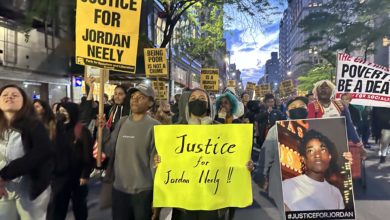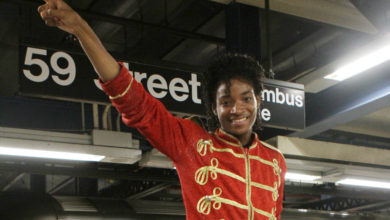Less than 24
hours after the legal lynching of Troy Davis by the state of Georgia,
hundreds of angry New Yorkers rallied at Union Square to demonstrate
their outrage. What began as a relatively “normal” speak-out
against the racist death penalty had by night’s end turned into an
electric, spontaneous march throughout downtown Manhattan, in which
onlookers became participants, the police were put on their heels,
and the crowd lost its fear.
While there had
been no plan for a march, the militant energy of the mostly young
crowd led to chants of “March! March!” Not blocked by the
customary police barricades, the front of the march walked off the
sidewalk and into the streets. No one hesitated to follow. Suddenly,
the protesters found themselves being chased by the NYPD, who were
clearly unprepared for the people to take over 14th
Street.
From that point
forward, the march was as much a struggle against the NYPD’s
attempts to restrict and cut off the protest, as it was about Troy
Davis. Every time the NYPD tried to cut the march in half with their
motorcycles and long lines of heavily-armed officers, the crowd
responded powerfully with loud chants of “Whose Streets? Our
Streets!” At one key moment a few blocks from Union Square, the
crowd simply walked in between or around these motorcycles and
continued on. Having passed through, they turned around to condemn
the police restrictions: “We Are All Sean Bell—NYPD go to hell!”
| Confronting the first police line; Source: All Things Harlem |
| Source: Young Marxist |
While passing
through Greenwich Village and around New York University, the march
became like a magnet for those outraged by the execution of Troy
Davis. Some NYU students literally climbed out of their street-side
windows to join in the protest, as did pedestrians, shoppers, and
people eating dinner; the crowd swelled to 500-600 people. With
powerful unity, young people of all backgrounds chanted “The system
is racist—they lynched Troy Davis!” and “Death Row? Hell No!”
It was soon
clear, however, that the police intended to do whatever was necessary
to halt the people’s takeover of lower Manhattan. Backup was
quickly called, and within a few blocks, the crowd was trying to make
spontaneous decisions about which street to march down in order to
avoid a police blockade. On Franklin Street, the police barricaded
both the street and the sidewalk. They showed their true colors when
they began attacking the crowd, shoving people in order to provoke
them, or by hitting them with their batons. Officers pressed guns
loaded with rubber bullets into the chest of those who remained in
the streets. For a few minutes, Davis supporters were forced to the
sidewalks in a tense stand-off. Even after unleashing such
repression, it was clear that the crowd was not willing to disperse
as the police wanted.
The police
tactics backfired, and only strengthened the people’s desire to
continue on. Quickly coordinating with each other, the group began to
backtrack, until they reached a street that was relatively free from
the police presence. Again, the streets belonged to the young people
of New York! The NYPD began to realize they could do little to crush
the will of the crowd. Despite all their forces of
repression—including the hundreds of handcuffs they proudly
displayed—the march would not be stopped. Marching down Broadway to
the south end of Manhattan, the group pushed towards a natural
destination point: Wall Street. This is a natural target for any
protest against oppression, because Wall Street is where the real
power lies in the racist, capitalist system. It was also the site of
the “Occupy Wall Street” demonstration, which had been camped out
in Liberty Plaza for the previous five days.
As the march
celebrated having made it to their final destination, the NYPD
forces, now numbering in the several hundred, began to retaliate for
having been outmaneuvered all night long. Because a wall separates
the sidewalk from the park itself, many protesters still stood on the
streets. The police responded by pushing the crowd backwards,
dangerously trying to cram hundreds of people into a narrow stretch
of sidewalk. Many screamed out in pain and confusion, while two
trapped protesters were suddenly snatched up and arrested. They were
reportedly charged with “resisting arrest”—a ridiculous
accusation that shows they had no reason to be arrested to begin
with!
A short time
later, several others who continued to march down to Wall Street were
taken into custody. Instead of the night ending there, the people
again organized quickly, and at least 50 marched to the 1st Precinct
to demand their release. On arrival, police in riot gear refused to
allow the group anywhere near the entrance. In fact, protesters were
told that they were now blocking pedestrian traffic—there was
none—and that soon each and every person would be arrested.
Instead, some sat down, paying no attention to these orders, and
chanted, “Let our brothers go!” While the police did not release
the innocent protesters, those arrested later confirmed that they
heard our presence, and it lifted their spirits. The following day
the arrestees were released, but they each have pending court dates.
The march
exemplified the militant spirit of the youth, especially when they
have been pushed just a little too far. These youth are often
described as apolitical and apathetic, but the Troy Davis case
clearly touched a raw nerve in high schools, colleges, and oppressed
communities across the country. The march also clearly showed the
brutal character of the NYPD and their repressive instincts against
any semblance of a movement opposing the system.
The rally and
march only lasted for a few hours on one night, but it was a glimpse
of revolution, with oppressed and working-class youth losing their
fear. Truly, our generation is in fact at the beginning stages of
igniting the revolutionary movement that we need for the society that
we all deserve.






